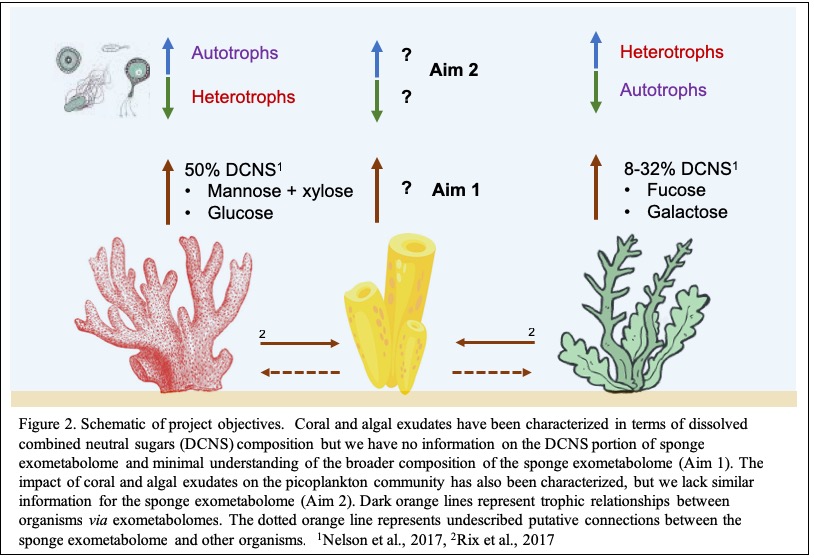Nutrient Cycling on Coral Reefs
Coral Reefs
Coral reefs are found in clear tropical waters, making them main attractions for tourists in many tropical regions. The clear water, however, is indicative of an oligotrophic, or nutrient poor, habitat. The existence of so much life in nutrient poor waters was considered a paradox (known as Darwin’s paradox) for a long time. We now know that the key to survival on coral reefs has to do with recycling of nutrients – often occurring within symbiotic associates such as with corals and symbiotic algae and sponges and symbiotic microbes.
Nitrogen is one key limiting nutrient on coral reefs. Organisms need nitrogen to build proteins and make DNA and RNA. Marine sponges are well known as sources of inorganic nitrogen (nitrate and ammonia), particularly on coral reefs. This nitrogen comes from a process known as nitrification that is performed by bacteria and archaea living within the sponge. We now know that other nitrogen transformations also occur in sponges, including denitrification, nitrogen fixation, and dissimilatory nitrate reduction to ammonia. What impact do these nitrogen transformations have on the availability of nitrogen on different coral reefs? Which microbes are performing these transformations? Do all of these occur in all sponges? Do sponges and their microbes influence the availability of other key nutrients like phosphorus and sulfur? These are some of the questions driving research in my lab related to inorganic nutrient cycling on coral reefs.
Another integral component of nutrient cycling in the marine environment is the pool of dissolved organic nutrients, also known as dissolved organic matter (DOM). The reservoir of DOM contains relatively simple organic molecules like vitamins and amino acids as well as more complex compounds like humic acids and tannins from plants. These are all dissolved in the seawater much like you would dissolve table sugar in a glass of water. The composition (what types of molecules are present) and concentration (how much is there) can influence the growth of other organisms (see microbial physiology). Our research has shown that sponges alter the composition and concentration of DOM – the former of which was something we did not know was happening until we began our pilot project. You can read more about the pilot project and associated blogs here and read the publication here.
Our current work is focused on two projects
Microbially-mediated ecological diversification in Caribbean Sponges:
This NSF-funded project is collaborative with Cole Easson (MTSU), Chris Freeman (CofC), and Bob Thacker (SUNY Stony Brook). We are testing the long-time paradigm that phototrophic sponges are found in the Great Barrier Reef and not in the Caribbean. In fact, we hypothesize that microbial symbionts of sponges, including photosymbionts (e.g., Cyanobacteria) have helped drive a continuum of sponge nutritional strategy from largely heterotrophic to largely phototrophic. We completed our first field season this summer at the Smithsonian Tropical Research Station in Bocas del Toro, Panama. I also was able to co-teach a sponge taxonomy and ecology workshop at STRI this summer and it was a wonderful sponge-filled time!

Instructors of the 2019 Sponge Taxonomy and Ecology Cs 
Building an artificial reef
The role of the sponge holobiont in structuring the composition of dissolved organic matter on coral reefs:
This NSF-funded project will build on previous work from my postdoc at WHOI and we will couple fluorometric and mass spectrometry based techniques to analyze changes in DOM composition as it passes through a sponge and we will investigate trophic implications of sponge filtration. Because sponges are abundant on Caribbean reefs and are efficient filter feeders, they are likely to drive large-scale changes in DOM composition on coral reefs. Additionally, the composition of DOM influences the types and abundance of microbes present in the seawater and other studies have shown that coral exudates tend to favor ‘healthy’ autotrophic microbes while algal exudates tend to favor heterotrophs including opportunistic pathogens. (See an article on our work in the ASU news.)
We hope to discover how sponges fit into this paradigm.

Sponges may not look like they are active, but most of the time they are pumping massive amounts of water through their bodies – effectively filtering all of the water overlying the coral reef in a matter of days! This video shows sponge pumping activity using a non-toxic fluorescent dye.